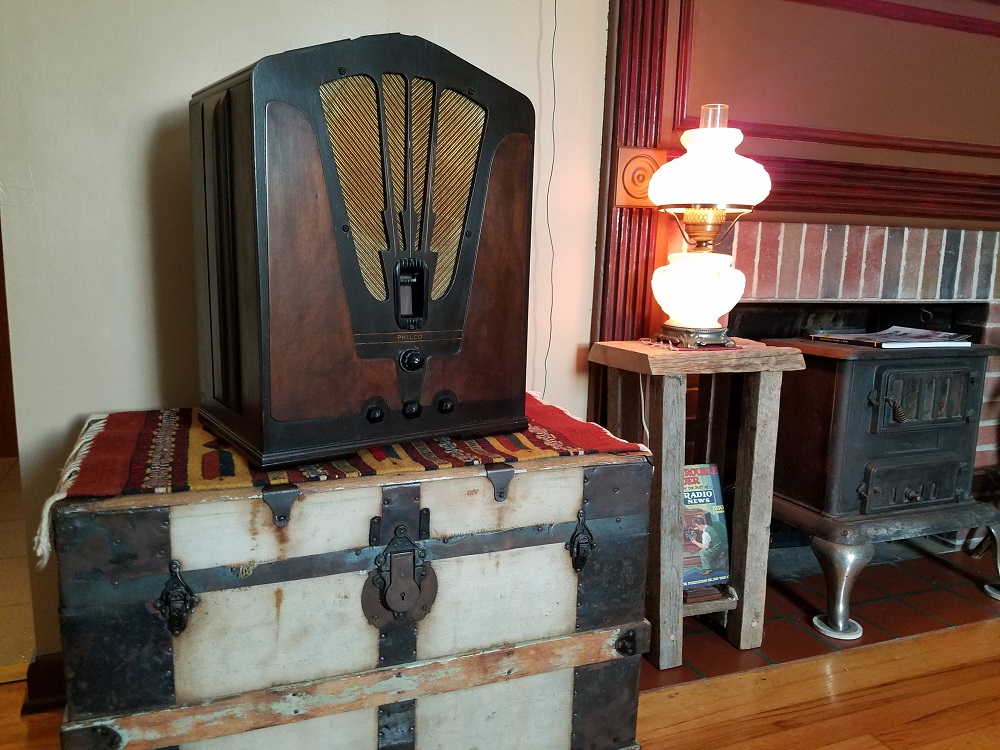New owner of 16b shouldered Tbone
Posts: 765
Threads: 147
Joined: Aug 2012
City: Dallas, TX
Posts: 4,603
Threads: 50
Joined: Sep 2008
City: Sandwick, BC, CA
Fred;
It looks like the front panel is still original, but that someone stripped and clear coated the top and sides. This isn't too surprising since the original shading lacquer has a habit of flaking off, I believe that the top, sides, front moldings, and the base were originally extra dark walnut, or something similar, if the 1936 model 116B is anything to go by. There is a picture of a 1935 model 16B, Ron's set, that is in the banner above this page actually.
Regards
Arran
Posts: 765
Threads: 147
Joined: Aug 2012
City: Dallas, TX
Thank,s Arran, I was thinking that the sides were supposed to be extra dark walnut along with the base molding. In the header banner for Rons radio looks good but dosen,t look like extra dark walnut, looks black but could be the lighting in picture. The raw looking wood on mine wont cut it, the front control panel seems to be correct with out hardly any clear on it yes it had been stripped at some point and not finished. The wood veneer on this set is tight and perfect. Will look fantastic wen refinished properly. Chassis will go thru my normal cleaning and service to get it up and playing safely.
Posts: 13,776
Threads: 580
Joined: Sep 2005
City: Ferdinand
State, Province, Country: Indiana
Correct - it was the (poor) lighting in the picture; the trim and sides are Extra Dark Walnut.
Another example is here, although the trim on this one is too light. It should be Extra Dark Walnut, but applied light enough that the grain still shows yet dark enough to make it very dark brown.
Now this 118B is not the same cabinet obviously, but has the same toning. You can tell the finish on this 118B is original as it is flaking. You can clearly see the contrast between the dark trim and the Medium Walnut front panel.
--
Ron Ramirez
Ferdinand IN
Posts: 765
Threads: 147
Joined: Aug 2012
City: Dallas, TX
Thanks Ron, I have refinished two early and late 16b,s using the extra dark walnut applying just enough toner to still see the grain. The diamond cloth or the chevron on my model? I have seen both cloth designs that seem to be factory on this model Philco.
Posts: 13,776
Threads: 580
Joined: Sep 2005
City: Ferdinand
State, Province, Country: Indiana
Chevron, not diamond, cloth is correct for the late version 16B.
--
Ron Ramirez
Ferdinand IN
Posts: 102
Threads: 14
Joined: Jul 2017
City: Bakersfield, CA
Great radio! It seems this version may be the hardest to find... at least for me!
Posts: 203
Threads: 20
Joined: Feb 2017
City: Orland Park
State, Province, Country: Illiinois
That switch on the side doesn't seem original
Greg
"We are here to laugh at the odds and live our lives so well that Death will tremble to take us."
Posts: 1,275
Threads: 44
Joined: Nov 2017
City: Menlo Park
State, Province, Country: CA
Greg,
It might be - some of the 16 series have an "Interstation Noise Suppressor" (old fashioned for squelch) and the switch allows this feature to be active or not. Typically, there will be a pot/rheostat to adjust the cut off point, accessible at the back of the chassis.
Cheers
Ed
I don't hold with furniture that talks.
Posts: 1,475
Threads: 69
Joined: Nov 2012
City: Kansas city, MO.
I believe it's a bass compensation switch.
Posts: 15,283
Threads: 531
Joined: Oct 2011
City: Jackson, NJ
Ed Holland is correct.
People who do not drink, do not smoke, do not eat red meat will one day feel really stupid lying there and dying from nothing.
Posts: 1,475
Threads: 69
Joined: Nov 2012
City: Kansas city, MO.
Wonder why they called it a bass compensation switch on the schematic? Just trying to learn.
Posts: 13,776
Threads: 580
Joined: Sep 2005
City: Ferdinand
State, Province, Country: Indiana
In the case of this model (the later 4-band 16), KCMike is correct.
It is my belief that Philco decided they needed a switch to fill a hole in already-produced 16 cabinets when they introduced the 4-band 16 in late 1934 (after the 1935 season had begun), so they stuck an SPST toggle switch in the bass compensation section of the volume control circuit. I can't prove it because there is no supporting (or refuting) evidence that I know of, but it is a logical assumption.
The 4-band 16 does not have the QAVC (squelch or "Quiet Automatic Volume Control") that the 5-band 16 had...but it does add an RF amp, which is better than having QAVC.
Study a 4-band 16 schematic to learn more and see how the switch is placed in the circuit.
--
Ron Ramirez
Ferdinand IN
Posts: 289
Threads: 42
Joined: Jan 2014
City: Jeffersonville
State, Province, Country: PA

Hello all -
The side switch on my 16b turns the set on/off.
Regards,
Paul
Posts: 1,856
Threads: 212
Joined: May 2015
City: Seattle
State, Province, Country: WA
Beautiful set Paul!
Your set was likely modified later on in its life - perhaps to compensate for the power switch on the back of the volume control potentiometer no longer working (very common).
Users browsing this thread: 1 Guest(s)
|



